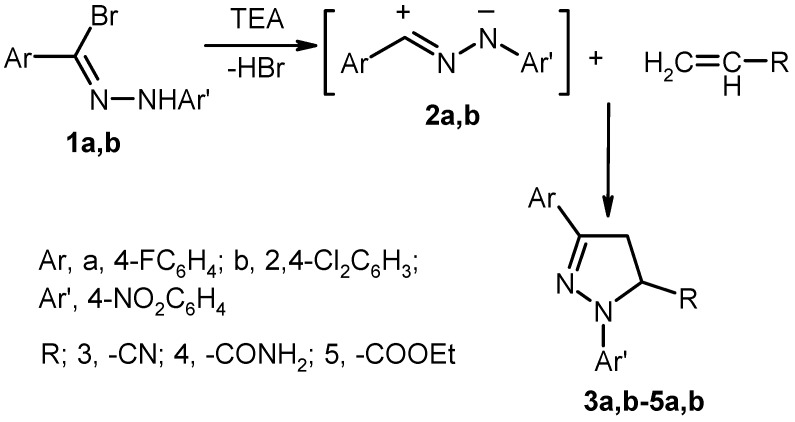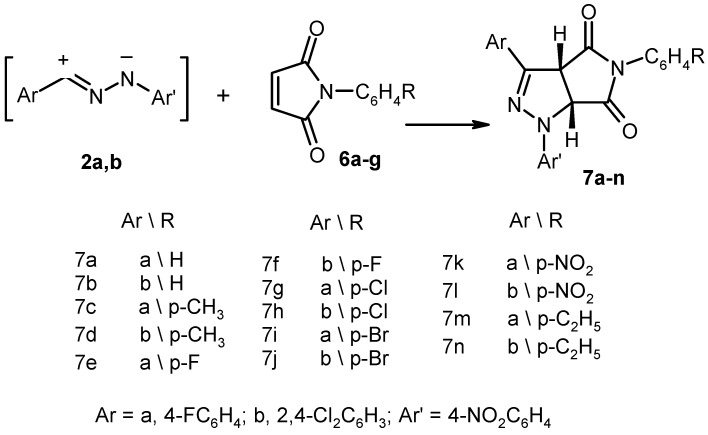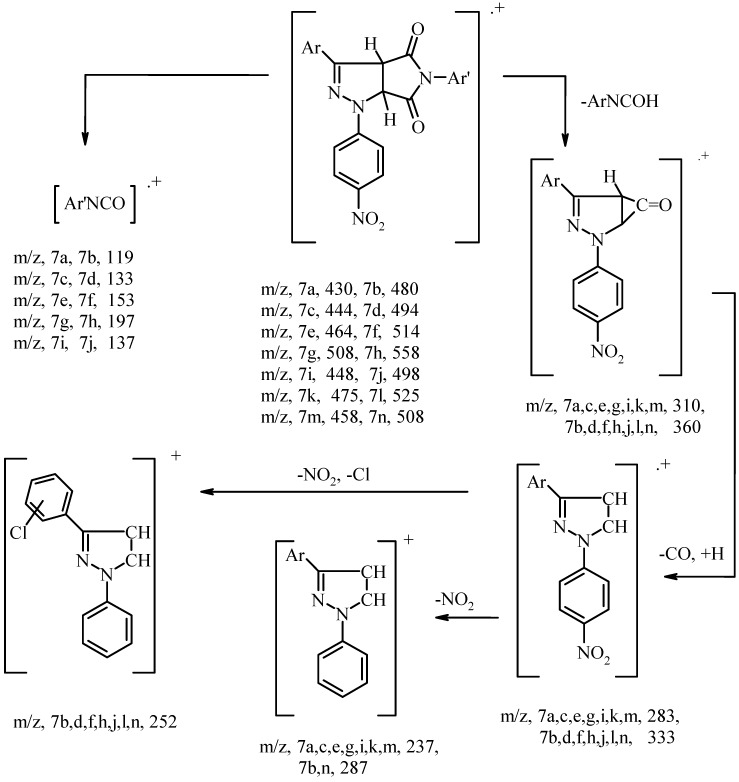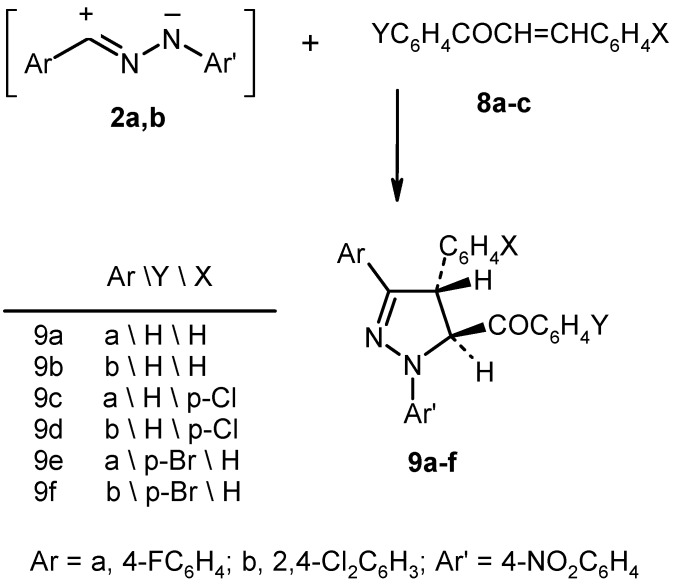Abstract
Several 1,3-diaryl-5-(cyano-, aminocarbonyl- and ethoxycarbonyl-)-2-pyrazoline, pyrrolo[3,4-c]pyrazole-4,6-dione and 1,3,4,5-tetraaryl-2-pyrazoline derivatives were prepared by the reaction of nitrilimine with different dipolarophilic reagents. The new compounds were characterized using IR, 1H-NMR, 13C-NMR and mass spectra. Biological screening of some compounds is reported.
Keywords: Pyrazoline; pyrrolo[3,4-c]pyrazole-4,6-dione; nitrilimine; dipolarophile; biological activity
Introduction
Considerable attention has been focused on pyrazolines and substituted pyrazolines due to their interesting biological activities. They have found to possess antifungal [1], antidepressant [2,3,4,5] anticonvulsant [4,5], anti-inflammatory [6], antibacterial [7] and anti-tumor [8] properties. Moreover, many selectively fluoro-substituted organic compounds show peculiar pharmacological and agro-chemical properties [9,10,11,12,13,14]. Several methods are employed in the synthesis of pyrazolines, including the condensation of chalcones with hydrazine, hydrazine derivatives [15,16,17,18,19] and thiosemicarbazide [20] under acidic [15,16] or basic [20] conditions, and the cycloaddition of nitrilimines, generated in situ from the corresponding hydrazonoyl halides by the action of a suitable base, to carbon-carbon double bonds of a suitable dipolarophile [21,22,23,24]. As a connection of our interest in the preparation of heterocyclic compounds from hydrazonoyl halides [21,22,23,24,25,26,27] and the above-mentioned findings, the work reported herein was aimed at the preparation of some new pyrazoline derivatives with anticipated biological activities.
Results and Discussion
The reactivity of the nitrilimines 2a,b, generated in situ by base catalyzed elimination of hydrogen bromide from hydrazonoyl bromides 1a,b, with various mono-, di- and tri-substituted dipolarophiles was examined. Thus, heating of equimolar amounts of 1a,b and each of acrylonitrile, acrylamide or ethyl acrylate in dry benzene in the presence of triethylamine gave exclusively 3-aryl-1-(4-nitrophenyl)-5-substituted-2-pyrazolines 3a,b-5a,b, respectively, in good yields (Scheme 1).
Scheme 1.
The assigned 5-substituted-2-pyrazoline structures 3-5 were supported by elemental analyses and spectroscopic data (see Experimental). The chemical shifts of the methine and methylene hydrogens in the 1H-NMR spectra of 3-5 compared favorably with those reported for the corresponding protons in 1-aryl-3-(2-naphthoyl)-5-substituted-2-pyrazolines [21]. Such similarity, while confirming the assigned structures, indicates that both substituents, the 4-fluorophenyl- and 2,4-dichlorophenyl-, have similar effects on the chemical shifts of the methylene protons at C-4 of substituted 2-pyrazoline derivatives, compared with the 2-naphthoyl- group. The structures of 3a,b were also confirmed by the absence of the nitrile absorption in the IR spectra, as observed in the case of aliphatic nitriles activated by a nitrogen or an oxygen atom in the β-position [28,29]. The IR spectra of 4a,b showed the C=O amide absorption band at υ 1680 cm-1 and NH2 absorption bands at υ 3420 and 3300 cm-1. The IR of 5a,b exhibited an ester carbonyl absorption band near υ 1730 cm-1. The 13C-NMR spectrum of 5b displays the characteristic signals of the suggested structure. The signal for the carbonyl carbon of ester group appears at δ 169.4 ppm, the signals for pyrazoline C-4 at δ 39.9, pyrazoline C-5 at δ 59.9, the ester group methylene carbon at δ 61.6 and ester group methyl carbon at δ 13.8 ppm (see Figure 1 for the carbon numbering).
Figure 1.
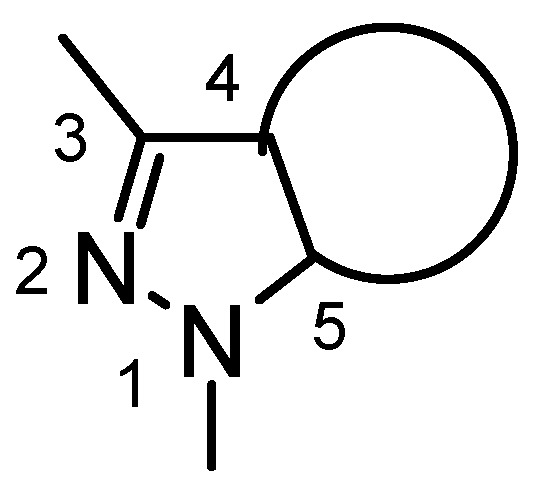
Treatment of each of the hydrazonoyl bromides 1a and 1b with N-arylmaleimides 6a-g in refluxing chloroform in the presence of triethylamine gave the corresponding cycloadducts 7a-n, respectively (Scheme 2).
Scheme 2.
The structure of the latter products was elucidated on the basis of their elemental analyses and the study of their spectroscopic data (see Experimental). The IR spectra of products 7 exhibit characteristic bands near υ 1720 cm-1, assignable to a carbonyl group. The 1H-NMR spectra of all compounds showed, in each case, two doublets near δ 5.5 and 5.8 ppm, assignable to the protons at C-3a and C-6a, respectively. The vicinal coupling constants have been shown to be diagnostic, Jtrans < (6 Hz), Jcis (9-12 Hz) [30,31], so the observed values of the coupling constants (J = 10.0-11.5 Hz) are compatible with the expected cis-configuration. On the basis of these spectroscopic data, the products 7a-n were assigned 3a,4,6,6a-tetrahydro-3,5-diaryl-1-(4-nitrophenyl)-1H,5H-pyrrolo[3,4-c]pyrazole-4,6-dione structures. The 13C-NMR spectrum of 7m exhibited two signals at δ 171.49 and 170.59 for the two amide carbonyl carbons. The signals at δ 66.54, 53.81, 27.33 and 14.78 are assignable to C-5 pyrazoline, C-4 pyrazoline (Figure 1) and the methylene and methyl carbons of the ethyl group respectively. The mass spectra of all prepared compounds 7a-n displayed the correct molecular ion peaks. All molecular ion fragments seem to go through similar fragmentation pattern since the products with Ar = 4-FC6H4 show the same fragment signals at M+, 310, 283, 237 and the products with Ar = 2,4-Cl2C6H3 show the same fragments at M+, 360, 333, 352. The fragmentation pattern of compounds 7 are shown in Scheme 3.
Scheme 3.
Also, treatment of the hydrazonoyl bromides 1a,b with the appropriate α,β-unsatruated ketones 8a–c in benzene in the presence of triethylamine afforded, in each case, one regioisomer, as evidenced by TLC analysis. The structures of the products obtained were identified as 9a-f respectively (Scheme 4). The structures of compounds 9 were assigned on the basis of their elemental analyses and spectroscopic data (see Experimental). The 1H-NMR spectra of 9 were characterized, in each case, by the presence of two doublets (J = 3.6-6.0 Hz) near δ 5.2 and 6.5 ppm, assignable to the protons at C-4 and C-5 of the pyrazoline ring respectively [32].
Scheme 4.
On the basis of the coupling constant values [30,31], the cycloadducts 9 were assigned the trans-configuration. The 13C-NMR spectra of compounds 9b and 9f revealed characteristic signals at δ 192.32 (191.71), 150.30 (150.29), 70.71 (70.63) and 56.54 (56.29) ppm, assignable to C=O, C=N, C–5 pyrazoline and C-4 pyrazoline, respectively. Also, the mass spectra of compounds 9 displayed molecular ion peaks in accordance with the suggested structures. The base peaks occur from elimination of benzoyl or bromobenzoyl at M+-105 or M+-183 respectively. Consequent loss of NO2 gives fragments at M+-(105+46) or M+-(183+46), respectively. Other characteristic fragments resulting from cleavage β- to the carbonyl group also appeared at 105 or 183.
Antimicrobial activity
Four of the newly synthesized compounds were screened for their antibacterial activity against the Gram –ve bacteria Escherchia coli and the Gram +ve bacteria Staphylococcus aureus, in addition to their antifungal activity against Asperagillus flavus and Candida albicans using the agar diffusion method [33,34] at a concentration 20 mg/mL using DMSO as a solvent. The results, recorded as average diameter of inhibition zone in mm, are given in Table I.
Table 1.
Antimicrobial screening results of the tested compounds*.
| Comp. No. | E. coli | S. aureus | A. flavus | C. albicans |
|---|---|---|---|---|
| 3a | 11 | 11 | 0.0 | 11 |
| 7i | 11 | 11 | 0.0 | 10 |
| 7n | 11 | 11 | 0.0 | 10 |
| 9c | 12 | 12 | 0.0 | 10 |
| Tetracycline | 32 | 34 | -- | -- |
| Flucoral | -- | -- | 14 | 16 |
| Amphotricine | -- | -- | 16 | 20 |
* Zone of inhibition in mm
Experimental
General
All melting points were measured on an Electrothermal melting point apparatus and are uncorrected. The infrared spectra were recorded in potassium bromide disks on a Pye Unicam SP 3–300 or a Shimadzu FT-IR 8101 PC infrared spectrophotometer. The 1H-NMR (200 MHz) and 13C- NMR (50 MHz) spectra were recorded in DMSO-d6 on a Varian Mercury VX 200 NMR using TMS as the internal reference. Mass spectra were measured on a GCMS-QP 1000 EX spectrometer at 70 eV. Elemental analyses were carried out at the Microanalytical Centre of Cairo University, Giza, Egypt. Compounds 1a [35] and 1b [36] were prepared according to the methods reported in the literature.
Synthesis of 1,3,5-trisubstituted-2-pyrazoline derivatives 3a,b-5a,b
To a solution of hydrazonoyl bromides 1a,b (0.005 mol) and the appropriate monosubstituted olefin (acrylonitrile, acrylamide and ethyl acrylate, 0.005 mol) in chloroform (50 mL) was added triethylamine (0.7 mL, 0.005 mol) at room temperature. The mixture was refluxed for 4-6 h and then cooled. The mixture was extracted with water and the organic layer was collected, dried (anhydrous sodium sulfate) and then filtered. The solvent was evaporated and the residue was triturated with methanol whereupon it solidified. The solid was collected and recrystallized from the indicated solvents to give the corresponding cycloadducts 3-5 in good yield.
5-Cyano-3-(4-fluorophenyl)-1-(4-nitrophenyl)-2-pyrazoline (3a). Yellowish brown solid; mp. 222-4 oC (from acetic acid); yield 73 %; IR: ν/cm-1 3083.3 (CH-aromatic), 1596.5 (C=N); MS, m/z: 310 (M+, 60.4), 284 (50.8), 283 (100.0), 236 (17.4), 133 (12.4), 95 (21.6), 90 (27.1), 75 (25.7), 63 (33.2), 50 (25.1); 1H-NMR: δ/ppm 3.79-3.94 (dd, 1H, J = 18.0, 12.0 Hz), 3.96-4.07 (dd, 1H, J = 18.0, 6.0 Hz), 5.86-5.94 (dd, 1H, J = 12.0, 6.0 Hz), 7.29-8.27 (m, 8H, ArH's); Anal. Calcd. for C16H11FN4O2: C, 61.93; H, 3.57; N, 18.05; Found: C, 61.81; H, 3.63; N, 17.97.
5-Cyano-3-(2,4-dichlorophenyl)-1-(4-nitrophenyl)-2-pyrazoline (3b). Yellow solid; mp. 164-6 oC (from dioxane-ethanol); yield 63 %; IR: ν/cm-1 3091.3 (CH-aromatic), 1595.8 (C=N); MS, m/z: 362 (m++2, 27.8), 360 (M+, 45.3), 333 (78.5), 335 (37.9), 287 (14.7), 252 (23.3), 190 (10.0), 171 (18.1), 136 (20.7), 116 (32.5), 90 (63.8), 75 (59.9), 63 (100.0), 50 (74.6); 1H-NMR: δ/ppm 4.03 (d, 2H, J = 8.0 Hz), 5.94 (t, 1H, J = 8.0 Hz), 7.38-8.33 (m, 7 H, ArH's); Anal. Calcd. for C16H10Cl2N4O2: C, 53.20; H, 2.79; N, 15.51; Cl, 19.63; Found: C, 53.15; H, 2.87; N, 15.42; Cl, 19.60.
5-Aminocarbonyl-3-(4-fluorophenyl)-1-(4-nitrophenyl)-2-pyrazoline (4a). Orange yellow solid; mp. 301-3 oC (from dioxane); yield 54 %; IR: ν/cm-1 3423.6, 3304.8 (NH2), 3185.3, 3078.3 (CH-aromatic), 1683.4 (C=O amide), 1598.2 (C=N); MS, m/z: 328 (M+, 11.3), 284 (100.0), 238 (56.6), 90 (12.9), 76 (16.3), 50 (14.9); 1H-NMR: δ/ppm 3.44-3.58 (dd, 1H, J = 17.4, 6.0 Hz), 3.76-3.91 (dd, 1H, J = 17.4, 12.4 Hz), 4.93-5.02 (dd, 1H, J = 12.4, 6.0 Hz), 7.06-8.19 (m, 10 H, ArH's, NH2); Anal. Calcd. for C16H13FN4O3: C, 58.53; H, 3.99; N, 17.06; Found: C, 58.56; H, 3.87; N, 16.89.
5-Aminocarbonyl-3-(2,4-dichlorophenyl)-1-(4-nitrophenyl)-2-pyrazoline (4b). Orange yellow solid; mp. 257-9 oC (from dioxane); yield 53 %; IR: ν/cm-1 3420.5, 3313.9 (NH2), 3074.8 (CH-aromatic), 1683.8 (C=O amide), 1595.1 (C=N); MS, m/z: 380 (M++2, 7.2), 378 (M+, 9.8), 336 (67.5), 334 (100.0), 290 (29.5), 288 (48.1), 90 (11.8), 76 (12.8), 63 (10.3), 50 (10.6); 1H-NMR: δ/ppm 3.44-3.57 (dd, 1H, J = 6.6, 18.4 Hz), 3.88-4.03 (dd, 1H, J = 18.4, 12.6 Hz), 4.94-5.04 (dd, 1H, J = 12.6, 6.6 Hz), 7.07-8.21 (m, 9H, ArH's, NH2); Anal. Calcd. for C16H12N4O3Cl2: C, 50.67; H, 3.18; N, 14.77; Cl, 18.69; Found: C, 50.66; H, 3.20; N, 14.78; Cl, 18.69.
5-Ethoxycarbonyl-3-(4-fluorophenyl)-1-(4-nitrophenyl)-2-pyrazoline (5a). Yellow solid; mp. 184-6 oC (from benzene); yield 58 %; IR: ν/cm-1 3071.9 (CH-aromatic), 2977.1, 2935.3 (CH-aliphatic), 1733.2 (C=O ester), 1593.4 (C=N); MS, m/z: 357 (M+, 18.7), 284 (100.0), 238 (57.4), 90 (10.2), 75 (12.6), 50 (7.4); 1H-NMR: δ/ppm 1.21 (t, 3H, J = 7.4 Hz, COOCH2CH3), 3.60-3.71 (dd, 1H, J = 18.2, 5.0 Hz), 3.82-3.97 (dd, 1H, J = 18.2, 12.4 Hz), 4.13-4.24 (q, 2H, J = 7.4 Hz, COOCH2CH3), 5.32-5.41 (dd, 1H, J = 12.4, 5.0 Hz), 7.12-8.20 (m, 8H, ArH's); Anal. Calcd. for C18H16FN3O4: C, 60.49; H, 4.51; N, 11.75; Found: C, 60.52; H, 4.41; N, 11.64.
5-Ethoxycarbonyl-3-(2,4-dichlorophenyl)-1-(4-nitrophenyl) -2-pyrazoline (5b). Orange yellow solid; mp. 130-2 oC (from acetic acid); yield 74 %; IR: ν/cm-1 3074.9 (CH-aromatic), 2997.8, 2980.4 (CH-aliphatic), 1728.8 (C=O ester), 1594.8 (C=N); MS, m/z: 409 (M++2, 10.8), 407 (M+, 16.2), 335 (100.0), 334 (92.9), 289 (45.7), 288 (50.9), 117 (10.7), 90 (23.9), 76 (25.2), 63 (22.2), 50 (20.1); 1H- NMR: δ/ppm 1.21 (t, 3H, J = 7.1 Hz, COOCH2CH3), 3.67-3.78 (dd, 1H, J = 18.0, 4.6 Hz), 3.94-4.09 (dd, 1H, J = 18.0, 12.8 Hz), 4.17-4.24 (q, 2H, J = 7.1 Hz, COOCH2CH3), 5.35-5.44 (dd, 1H, J = 12.8, 4.6 Hz), 7.14-8.21 (m, 7H, ArH's); 13C-NMR: δ/ppm 169.48 (C=O), 149.76 , 148.34 (C=N, C-NO2), 139.01, 134.60, 132.35, 131.85 (4C, ArC's), 130.47, 128.40, 127.63, 125.75, 112.28 (5C, ArCH's), 61.67 (CH2, ester), 59.93 (C-5, pyrazoline), 39.95 (C-4, pyrazoline), 13.86 (CH3); Anal. Calcd. for C18H15Cl2N3O4: C, 52.95; H, 3.70; N, 10.29; Cl, 17.36; Found: C, 52.93; H, 3.62; N, 10.18; Cl, 17.29.
Synthesis of 3,5-diaryl-1-(4-nitrophenyl)-3a,4,6,6a-tetrahydro-1H,5H-pyrrolo[3,4-c]pyrazole-4,6-dione derivatives 7a-n
Triethylamine (0.7 mL, 0.005 mol) was added to a solution of hydrazonoyl bromides 1a,b (0.005 mol) and the N-arylmaleimides 6a-g (0.005 mol) in benzene (50 mL). The mixture was refluxed for 2 h. The solid product was filtered off and washed with boiling ethanol (10 mL), then recrystallized from the indicated solvents to give 7a-n.
3-(4-Fluorophenyl)-1-(4-nitrophenyl)-5-phenyl-3a,4,6,6a-tetrahydro-1H,5H-pyrrolo[3,4-c]pyrazole-4,6-dione (7a). Yellow crystals; mp. 278-80 oC (from dimethylformamide); yield 91 %; IR: ν/cm-1 3065.3 (CH-aromatic), 1721.0 (C=O), 1595.3 (C=N); MS, m/z: 430 (M+, 100.0), 310 (20.2), 283 (54.1), 237 (19.3), 237 (19.3), 119 (23.5), 91 (24.1), 63 (22.9), 50 (12.4); 1H-NMR: δ/ppm 5.46 (d, 1H, J = 10.3 Hz), 5.83 (d, 1H, J = 10.3 Hz), 7.20-8.28 (m, 13H, ArH's); Anal. Calcd. for C23H15FN4O4: C, 64.18; H, 3.51; N, 13.01; Found: C, 63.99; H, 3.48; N, 12.98.
3-(2,4-Dichlorophenyl)-1-(4-nitrophenyl)-5-phenyl-3a,4,6,6a-tetrahydro-1H,5H-pyrrolo[3,4-c]-pyrazole-4,6-dione (7b). Yellow crystals; mp. 206-7 oC (from toluene-ethanol); yield 94 %; IR: ν/cm-1 3072.0 (CH-aromatic), 1719.2 (C=O), 1594.8 (C=N); MS, m/z: 484 (M++4, 16.8), 482 (M++2, 68.6), 480 (M+, 100.0), 364 (5.2), 362 (20.6), 360 (33.0), 337 (13.6), 335 (60.9), 333 (74.8), 287 (15.1), 252 (29.9), 216 (13.2), 173 (14.9), 119 (49.8), 90 (79.4), 91 (68.2), 76 (51.0), 75 (48.0), 64 (65.6), 63 (89.6), 51 (33.7), 50 (42.2); 1H-NMR: δ/ppm 5.52 (d, 1H, J = 10.2 Hz), 5.86 (d, 1H, J = 10.2 Hz), 7.15-8.28 (m, 12H, ArH's); Anal. Calcd. for C23H14Cl2N4O4: C, 57.39; H, 2.93; N, 11.64; Cl, 14.73; Found: C, 57.48; H, 3.02; N, 11.71; Cl, 14.71.
3-(4-Fluorophenyl)-1-(4-nitrophenyl)-5-(4-methylphenyl)-3a,4,6,6a-tetrahydro-1H,5H-pyrrolo[3,4-c]pyrazole-4,6-dione (7c). Yellow crystals; mp. 304-6 oC (from dimethylformamide); yield 92 %; IR: ν/cm-1 3066.2 (CH-aromatic), 2952.9 (CH-aliphatic), 1718.8 (C=O), 1595.2 (C=N); MS, m/z: 444 (M+, 100.0), 310 (16.5), 283 (62.3), 237 (14.1), 133 (29.7), 117 (14.0), 104 (17.7), 90 (18.9), 63 (17.7), 50 (12.2); 1H-NMR: δ/ppm 2.33 (s, 3H, CH3), 5.44 (d, 1H, J = 10.9 Hz), 5.81 (d, 1H, J = 10.9 Hz), 7.18-8.28 (m, 12H, ArH's); Anal. Calcd. for C24H17FN4O4: C, 64.86; H, 3.85; N, 12.60; Found: C, 64.65; H, 3.79; N, 12.57.
3-(2,4-Dichlorophenyl)-1-(4-nitrophenyl)-5-(4-methylphenyl)-3a,4,6,6a-tetrahydro-1H,5H-pyrrolo-[3,4-c]pyrazole-4,6-dione (7d). Yellow crystals; mp. 275-7 oC (from dimethylformamide); yield 91 %; IR: ν/cm-1 3089.4 (CH-aromatic), 2952.4 (CH-aliphatic), 1720.1 (C=O), 1593.8 (C=N); MS, m/z: 498 (M++4, 16.6), 496 (M++2, 63.5), 494 (M+, 100.0), 335 (51.6), 333 (71.0), 252 (20.4), 133 (86.3), 132 (63.5), 117 (36.2), 116 (37.3), 105 (27.8), 104 (52.4), 91 (36.6), 90 (53.6), 89 (33.5), 78 (37.6), 77 (47.0), 76 (39.9), 75 (29.7), 63 (61.2), 51 (31.6), 50 (35.2); 1H-NMR: δ/ppm 2.34 (s, 3H, CH3), 5.55 (d, 1H, J = 10.8 Hz), 5.86 (d, 1H, J = 10.8 Hz), 7.15-8.29 (m, 11H, ArH's); Anal. Calcd. for C24H16Cl2N4O4: C, 58.19; H, 3.25; N, 11.31; Cl, 14.31; Found: C, 58.19; H, 3.34; N, 11.32; Cl, 14.28.
5-(4-Chlorophenyl)-3-(4-fluorophenyl)-1-(4-nitrophenyl)-3a,4,6,6a-tetrahydro-1H,5H-pyrrolo[3,4-c]-pyrazole-4,6-dione (7e). Dark yellow crystals; mp. 298-300 oC (from dimethylformamide); yield 94 %; IR: ν/cm-1 3064.7 (CH-aromatic), 1721.4 (C=O), 1595.1 (C=N); MS, m/z: 464 (M+, 92.1), 310 (25.0), 283 (100.0), 237 (20.4), 153 (26.8), 90 (38.1), 63 (34.7), 50 (16.2); 1H-NMR: δ/ppm 5.43 (d, 1H, J = 10.6 Hz), 5.81 (d, 1H, J = 10.6 Hz), 7.32-8.27 (m, 12H, ArH's); Anal. Calcd. for C23H14ClFN4O4: C, 59.42; H, 3.03; N, 12.05; Found: C, 59.39; H, 3.07; N, 11.98.
5-(4-Chlorophenyl)-3-(2,4-dichlorophenyl)-1-(4-nitrophenyl)-3a,4,6,6a-tetrahydro-1H,5H-pyrrolo-[3,4-c]pyrazole-4,6-dione (7f). Yellow crystals; mp. 268-70 oC (from dimethylformamide); yield 90 %; IR: ν/cm-1 3091.3 (CH-aromatic), 1719.2 (C=O), 1590.9 (C=N); MS, m/z: 520 (M++6, 6.3), 518 (M++4, 28.6), 516 (M++2, 92.1), 514 (M+, 100.0), 362 (20.9), 360 (27.6), 335 (49.8), 333 (80.6), 254 (8.0), 252 (24.0), 188 (11.9), 153 (53.4), 125 (57.0), 117 (25.9), 116 (31.3), 90 (74.6), 63 (72.5), 50 (32.8); 1H-NMR: δ/ppm 5.55 (d, 1H, J = 11.3 Hz), 5.87 (d, 1H, J = 11.3 Hz), 7.16-8.29 (m, 11H, ArH's); Anal. Calcd. for C23H13Cl3N4O4: C, 53.56; H, 2.54; N, 10.86; Cl, 20.62; Found: C, 53.64; H, 2.57; N, 10.90; Cl, 20.57.
5-(4-Bromophenyl)-3-(4-fluorophenyl)-1-(4-nitrophenyl)-3a,4,6,6a-tetrahydro-1H,5H-pyrrolo[3,4-c]pyrazole-4,6-dione (7g). Yellow crystals; mp. 306-8 oC (from dimethylformamide); yield 96 %; IR: ν/cm-1 3084.3 (CH-aromatic), 1721.7 (C=O), 1594.8 (C=N); MS, m/z: 510 (M++2, 60.6), 508 (M+, 69.9), 310 (27.2), 283 (100.0), 237 (26.9), 197 (22.7), 133 (13.9), 116 (25.5), 90 (69.1), 63 (50.5), 50 (22.5); 1H-NMR: δ/ppm 5.45 (d, 1H, J = 10.8 Hz), 5.81 (d, 1H, J = 10.8 Hz), 7.31-8.27 (m, 12H, ArH's); Anal. Calcd. for C23H14BrFN4O4: C, 54.24; H, 2.77; N, 11.00; Found: C, 54.15; H, 2.84; N, 10.97.
5-(4-Bromophenyl)-3-(2,4-dichlorophenyl)-1-(4-nitrophenyl)-3a,4,6,6a-tetrahydro-1H,5H-pyrrolo-[3,4-c]pyrazole-4,6-dione (7h). Yellow crystals; mp. 283-5 oC (from dimethylformamide); yield 93 %; IR: ν/cm-1 3085.5 (CH-aromatic), 1719.2 (C=O), 1590.9 (C=N); MS, m/z: 564 (M++6, 14.7), 562 (M++4, 43.2), 560 (M++2, 96.4), 558 (M+, 73.5), 362 (26.7), 360 (40.3), 335 (59.7), 333 (88.2), 252 (30.7), 197 (35.3), 171 (31.8), 116 (40.0), 90 (100.0), 76 (42.9), 63 (81.2), 50 (34.1); 1H-NMR: δ/ppm 5.56 (d, 1H, J = 10.3 Hz), 5.87 (d, 1H, J = 10.3 Hz), 7.15-8.28 (m, 11H, ArH's); Anal. Calcd. for C23H13BrCl2N4O4: C, 49.31; H, 2.33; N, 10.00; Cl, 12.65; Found: C, 49.50; H, 2.38; N; 10.06; Cl, 12.59.
3,5-Di-(4-fluorophenyl)-1-(4-nitrophenyl)-3a,4,6,6a-tetrahydro-1H,5H-pyrrolo[3,4-c]pyrazole-4,6-dione (7i). Yellow crystals; mp. 292-4 oC (from dimethylformamide); yield 96 %; IR: ν/cm-1 3076.5 (CH-aromatic), 1721.6 (C=O), 1595.3 (C=N); MS, m/z: 448 (M+, 100.0), 310 (23.5), 283 (60.5), 237 (21.2), 137 (28.6), 117 (13.1), 109 (40.8), 90 (26.3), 63 (28.1), 50 (20.6), 1H-NMR: δ/ppm 5.48 (d, 1H, J = 10.9 Hz), 5.87 (d, 1H, J = 10.9 Hz), 7.32-8.27 (m, 12H, ArH's); Anal. Calcd. for C23H14F2N4O4: C, 61.60; H, 3.14; N, 12.49; Found: C, 61.52; H, 3.20; N, 12.51.
3-(2,4-Dichlorophenyl)-5-(4-flurophenyl)-1-(4-nitrophenyl)-3a,4,6,6a-tetrahydro-1H,5H-pyrrolo[3,4-c]pyrazole-4,6-dione (7j). Yellow crystals; mp. 244-6 oC (from dimethylformamide); yield 92 %; IR: ν/cm-1 3081.6 (CH-aromatic), 1718.2 (C=O), 1590.0 (C=N); MS, m/z: 502 (M++4, 15.1), 500 (M++2, 68.0), 498 (M+, 100.0), 362 (17.0), 360 (26.8), 335 (37.5), 333 (56.3), 254 (4.7), 252 (16.2), 137 (34.7), 109 (46.7), 75 (16.6), 63 (24.0), 50 (14.8); 1H-NMR: δ/ppm 5.54 (d, 1H, J = 11.0 Hz), 5.85 (d, 1H, J = 11.0 Hz), 7.17-8.30 (m, 11H, ArH's); Anal. Calcd. for C23H13Cl2FN4O4: C, 55.32; H, 2.62; N, 11.22; Cl, 14.20; Found: C, 55.41; H, 2.65; N, 11.34; Cl, 14.13.
3-(4-Fluorophenyl)-1,5-di-(4-nitrophenyl)-3a,4,6,6a-tetrahydro-1H,5H-pyrrolo[3,4-c]pyrazole-4,6-dione (7k). Yellow crystals; mp. 308-10 oC (from dimethylformamide); yield 98 %; IR: ν/cm-1 3079.4 (CH-aromatic), 1725.2 (C=O), 1595.2 (C=N); MS, m/z: 475 (M+, 100.0), 310 (25.2), 283 (60.2), 237 (20.1), 188 (10.5), 134 (12.9), 133 (11.1), 116 (19.2), 90 (46.7), 63 (38.2), 50 (15.6); 1H-NMR: δ/ppm 5.57 (d, 1H, J = 11.2 Hz), 5.87 (d, 1H, J = 11.2 Hz), 7.16-8.29 (m, 12H, ArH's); Anal. Calcd. for C23H14FN5O6: C, 58.10; H, 2.96; N, 14.73; Found: C, 57.98; H, 3.06; N, 14.64.
3-(2,4-Dichlorophenyl)-1,5-di-(4-nitrophenyl)-3a,4,6,6a-tetrahydro-1H,5H-pyrrolo[3,4-c]pyrazole-4,6-dione (7l). Yellow crystals; mp. 225-7 oC (from acetic acid); yield 93 %; IR: ν/cm-1 3085.5 (CH-aromatic), 1725.9 (C=O), 1591.9 (C=N); MS, m/z: 529 (M++4, 18.5), 527 (M++2, 58.2), 525 (M+) (74.6), 362 (25.3), 360 (35.5), 335 (31.4), 333 (46.3), 254 (7.9), 252 (23.9), 189 (32.3), 188 (32.5), 171 (16.5), 158 (28.8), 116 (35.1), 90 (100.0), 76 (49.5), 63 (85.4), 50 (40.6); 1H-NMR: δ/ppm 5.57 (d, 1H, J = 11.6 Hz), 5.87 (d, 1H, J = 11.6 Hz), 7.16-8.29 (m, 11H, ArH's); Anal. Calcd. for C23H13Cl2N5O6: C, 52.48; H, 2.49; N, 13.30; Cl, 13.47; Found: C, 52.53; H, 2.51; N, 13.38; Cl, 13.34.
5-(4-Ethylphenyl)-3-(4-fluorophenyl)-1-(4-nitrophenyl)-3a,4,6,6a-tetrahydro-1H,5H-pyrrolo[3,4-c]-pyrazole-4,6-dione (7m). Yellow crystals; mp. 282-4 oC (from dimethylformamide); yield 98 %; IR: ν/cm-1 3074.3 (CH-aromatic), 2963.0 (CH-aliphatic), 1720.3 (C=O), 1594.5 (C=N); MS, m/z: 458 (M+, 100.0), 310 (16.6), 283 (64.9), 237 (11.6), 132 (38.1), 77 (11.3); 1H-NMR: δ/ppm 1.18 (t, 3H, J = 7.6 Hz, CH2CH3), 2.58 (q, 2H, J = 7.6 Hz, CH2CH3), 5.44 (d, 1H, J = 10.6 Hz), 5.81 (d, 1H, J = 10.6 Hz), 7.21-8.28 (m, 12H, ArH's); 13C-NMR: δ/ppm 171.49, 170.59 (two C=O amide), 165.24 (d, J = 248.7 Hz, C-F), 148.14 , 146.48 (C=N, C-NO2), 144.13, 139.38, 129.58 (d, J = 8.4 Hz, C-m-F), 128.89, 127.78, 126.37, 126.00 (d, J = 3.1 Hz, C-p-F), 125.04, 115.38 (d, J = 22.1 Hz, C-o-F), 112.81, 66.54 (C-5 pyrazoline), 53.81 (C-4 pyrazoline), 27.33 (CH2CH3), 14.78 (CH2CH3); Anal. Calcd. for C25H19FN4O4: C, 65.49; H, 4.17; N, 12.22; Found: C, 65.48; H, 3.99; N, 12.18.
3-(2,4-Dichlorophenyl)-5-(4-ethylphenyl)-1-(4-nitrophenyl-)-3a,4,6,6a-tetrahydro-1H,5H-pyrrolo[3,4-c]pyrazole-4,6-dione (7n). Yellow crystals; mp. 224-6 oC (from dimethylformamide); yield 95 %; IR: ν/cm-1 3071.5 (CH-aromatic), 2958.8 (CH-aliphatic), 1719.1 (C=O), 1593.9 (C=N); MS, m/z: 512 (M++4, 9.8), 510 (M++2, 72.5), 508 (M+, 100.0), 360 (23.8), 333 (47.4), 287 (10.4), 252 (18.9), 132 (84.3), 90 (25.7), 77 (16.6), 63 (19.0), 50 (11.5); 1H-NMR: δ/ppm 1.22 (t, 3H, J = 7.6 Hz, CH2CH3), 2.67 (q, 2H, J = 7.6 Hz, CH2CH3), 5.58 (d, 1H, J = 10.4 Hz), 5.89 (d, 1H, J = 10.4 Hz), 7.21-8.32 (m, 11H, ArH's); Anal. Calcd. for C25H18N4O4Cl2: C, 58.95; H, 3.56; N, 11.00; Cl, 13.92; Found: C, 59.00; H, 3.55; N, 10.98; Cl, 13.94.
Synthesis of 3,4,5-triaryl-1-(4-nitrophenyl)- 2-pyrazoline derivatives 9a-f
This reaction was carried out by the same method described for the preparation of pyrazolines 7 using the α,β-unsaturated ketone arylideneacetophenone derivatives 8a-c in place of N-arylmaleimides 6.
5-Benzoyl-3-(4-fluorophenyl)-1-(4-nitrophenyl)-4-phenyl-2-pyrazoline (9a). Yellow crystals; mp. 206-8 oC (from benzene); yield 75 %; IR: ν/cm-1 3068.4 (CH-aromatic), 1698.5 (C=O), 1593.2 (C=N); MS, m/z: 466 (M++1, 3.3), 465 (M+, 4.6), 361 (72.0), 360 (100.0), 315 (25.6), 314 (29.3), 105 (13.5), 77 (28.3), 51 (11.7); 1H-NMR: δ/ppm 5.23 (d, 1H, J = 3.0 Hz), 6.53 (d, 1H, J = 3.0 Hz), 7.13- 8.18 (m, 18H, ArH's); Anal. Calcd. for C28H20FN3O3: C, 72.24; H, 4.33; N, 9.02; Found: C, 72.71; H, 4.43; N, 9.13.
5-Benzoyl-3-(2,4-dichlorophenyl)-1-(4-nitrophenyl)-4-phenyl-2-pyrazoline (9b). Yellow crystals; mp. 148-50 oC (from benzene-ethanol); yield 71 %; IR: ν/cm-1 3064.3 (CH-aromatic), 1699.9 (C=O), 1593.8 (C=N), 1567.8 (C=C); MS, m/z: 517 (M++2, 2.9), 515 (M+) (3.5), 413 (55.2), 412 (59.4), 411 (91.7), 410 (100.0), 367 (18.9), 366 (20.0), 365 (26.1), 364 (30.3), 165 (14.4), 105 (50.9), 77 (82.1), 50 (16.4); 1H-NMR: δ/ppm 5.28 (d, 1H, J = 3.5 Hz), 6.58 (d, 1H, J = 3.5 Hz), 7.23- 8.19 (m, 17H, ArH's); 13C-NMR: δ/ppm 192.32 (C=O), 150.30 (C=N), 148.10, 138.68, 136.91, 134.09, 134.00, 132.48, 132.26, 132.01, 129.90, 128.97, 128.77, 128.62, 127.82, 127.18, 127.03, 126.95, 125.28, 112.33 (18C, ArC's), 70.71 (C-5 pyrazoline), 56.54 (C-4 pyrazoline); Anal. Calcd. for C28H19Cl2N3O3: C, 65.12; H, 3.70; N, 8.13; Cl, 13.73; Found: C, 65.32; H, 3.68; N, 8.24; Cl, 13.67.
5-Benzoyl-4-(4-chlorophenyl)-3-(4-fluorophenyl)-1-(4-nitrophenyl)-2-pyrazoline (9c). Yellow crystals; mp. 230-2 oC ( from benzene-ethanol); yield 68 %; IR: ν/cm-1 3063.5 (CH-aromatic), 1692.4 (C=O), 1655.8 (C=N), 1595.2 (C=C); MS, m/z: 502 (M++2, 1.5), 500 (M+, 5.1), 397 (32.4), 395 (100.0), 351 (9.4), 350 (12.2), 349 (30.4), 348 (28.0), 105 (24.9), 77 (40.0), 51 (17.8); 1H-NMR: δ/ppm 5.31 (d, 1H, J = 3.2 Hz), 6.52 (d, 1H, J = 3.2 Hz), 7.12- 8.17 (m, 17H, ArH's); Anal. Calcd. for C28H19ClFN3O3: C, 67.26; H, 3.83; N, 8.40; Found: C, 67.11; H, 3.86; N, 8.47.
5-Benzoyl-4-(4-chlorophenyl)-3-(2,4-dichlorophenyl)-1-(4-nitrophenyl)-2-pyrazoline (9d). Yellowish orange solid; mp. 204-6 oC (from benzene-ethanol); yield 61 %; IR: ν/cm-1 3065.3 (CH-aromatic), 1686.4 (C=O), 1594.8 (C=N), 1557.2 (C=C); MS, m/z: 551 (M++2, 5.4), 549 (M+, 6.5), 515 (5.7), 513 (8.5), 449 (33.1), 447 (100.0), 445 (90.2), 402 (7.7), 401 (19.1), 400 (23.9), 399 (23.9), 105 (34.7), 77 (56.5); 1H-NMR: δ/ppm 5.41 (d, 1H, J = 3.0 Hz), 6.55 (d, 1H, J = 3.0 Hz), 7.28- 8.36 (m, 16H, ArH's); Anal. Calcd. for C28H18Cl3N3O3: C, 61.05; H, 3.29; N, 7.62; Cl, 19.30; Found: C, 61.10; H, 3.36; N, 7.71; Cl, 19.19.
5-(4-Bromophenylcarbonyl)-3-(4-fluorophenyl)-1-(4-nitro-phenyl)-4-phenyl-2-pyrazoline (9e). Yellow solid; mp. 224-6 oC (from benzene); yield 53 %; IR: ν/cm-1 3068.6 (CH-aromatic), 1697.3 (C=O), 1655.4 (C=N), 1594.0 (C=N); MS, m/z: 543 (M+, 3.1), 361 (83.2), 360 (100.0), 315 (26.0), 314 (28.7), 183 (6.5), 91 (7.7), 76 (12.2), 50 (8.6); 1H-NMR: δ/ppm 5.22 (d, 1H, J = 3.3 Hz), 6.57 (d, 1H, J = 3.3 Hz), 7.13- 8.19 (m, 17H, ArH's); Anal. Calcd. for C28H19BrFN3O3: C, 61.77; H, 3.51; N, 7.71; Found: C, 61.76; H, 3.55; N, 7.73.
5-(4-Bromophenylcarbonyl)-3-(2,4-dichlorophenyl)-1-(4-nitrophenyl)-4-phenyl-2-pyrazoline (9f). Yellow solid; mp. 211-3 oC (from benzene); yield 51 %; IR: ν/cm-1 3072.7, 3030.9 (CH-aromatic), 1698.1 (C=O), 1592.2 (C=N); 1H-NMR: δ/ppm 5.27 (s, br., 1H, 4H-pyrazoline), 6.57 (s, br., 1H, 5H-pyrazoline), 7.24-8.20 (m, 16H, ArH's); 13C-NMR: δ/ppm 191.71 (C=O), 150.29 (C=N), 148.08, 138.73, 136.82, 134.01, 132.29, 131.98, 131.71, 131.51, 130.69, 129.01, 128.49, 127.86, 127.82, 127.09, 127.00, 126.85 125.28, 112.35 (18C, ArC's), 70.63 (C-5 pyrazoline), 56.29 (C-4 pyrazoline); Anal. Calcd. for C28H18N3O3BrCl2: C, 56.49; H, 3.04; N, 7.05; Cl, 11.91; Found: C, 56.48; H, 3.02; N, 7.0; Cl, 11.92.
Footnotes
Sample Availability: Contact the author.
References
- 1.Korgaokar S. S., Patil P. H., Shah M. J, Parekh H. H. Studies on Pyrazolines: Preparation and Antimicrobial Activity of 3-(3'(P-Chlorophenyesulphonamidophenyl)-5-aryl-1H/acetyl pyrazolines. Indian J. Pharm. Sci. 1996;58:222–225. [Google Scholar]
- 2.Palaska E., Aytemir M., Uzbay IT., Erol D. Synthesis and Antidepressant Activities of Some 3,5-diphenyl-2-pyrazolines. Eur. J. Med. Chem. 2001;36:539–543. doi: 10.1016/S0223-5234(01)01243-0. [DOI] [PubMed] [Google Scholar]
- 3.Rajendra P. Y., Lakshmana R. A., Prasoona L., Murali K., Ravi K. P. Synthesis and Antidepressant Activity of Some 1,3,5-Triphenyl-2-pyrazolines and 3-(2''-Hydroxynaphthalen-1''-yl)-1,5-diphenyl-2-pyrazolines. Bioorg. Med. Chem. Lett. 2005;15:5030–5034. doi: 10.1016/j.bmcl.2005.08.040. [DOI] [PubMed] [Google Scholar]
- 4.Ozdemir Z., Kandilici HB., Gumusel B., Calis U., Bilgin AA. Synthesis and Studies on Antidepressant and Anticonvulsant Activities of Some 3-(2-furyl)-pyrazoline Derivatives. Eur. J. Med. Chem. 2007;42:373–379. doi: 10.1016/j.ejmech.2006.09.006. [DOI] [PubMed] [Google Scholar]
- 5.Ruhogluo O., Ozdemir Z., Calis U., Gumusel B., Bilgin AA. Synthesis of and Pharmacological Studies on The Antidepressant and Anticonvulsant Activities of Some 1,3,5-trisubstituted Pyrazolines. Arzneimittelforschung. 2005;55:431–436. [PubMed] [Google Scholar]
- 6.Udupi R. H., Kushnoor A.S., Bhat A. R. Synthesis and Biological Evaluation of Certain Pyrazoline Derivatives of 2-[6-methoxynaphthyl]-propionic Acid (Naproxen) Indian J. Heterocycl. Chem. 1998;8:63–66. [Google Scholar]
- 7.Nauduri D., Reddy G. B. Antibacterials and Antimycotics: Part 1: Synthesis and Activity of 2-Pyrazoline Derivatives. Chem. Pharm. Bull. (Tokyo) 1998;46:1254–1260. doi: 10.1248/cpb.46.1254. [DOI] [PubMed] [Google Scholar]
- 8.Taylor E. C., Patel H. H. Synthesis of Pyrazol[3,4-d]pyrimidine Analogues of The Potent Agent N-{4-[2-(2-amino-4(3H)-oxo-7H-pyrrolo[2,3-d]pyrimidin-5-yl)ethyl]benzoyl}-l-glutamic acid (LY231514) Tetrahedron. 1992;48:8089–8100. doi: 10.1016/S0040-4020(01)80479-8. [DOI] [Google Scholar]
- 9.Koga H., Itoh A., Murayama S., Suzue S., Irikura T. Structure-Activity Relationships of Antibacterial 6,7- and 7,8-Disubstituted 1-Alkyl-1,4-dihydro-4-oxoquinoline-3-carboxylic acids. J. Med. Chem. 1980;23:1358–1363. doi: 10.1021/jm00186a014. [DOI] [PubMed] [Google Scholar]
- 10.Wilkinson J. A. Recent Advances in the Selective Formation of the Carbon-Fluorine Bond. Chem. Rev. 1992;92:505–519. doi: 10.1021/cr00012a002. [DOI] [Google Scholar]
- 11.Wise R., Andrews J. M., Edwards L. J. In Vitro Activity of Bay 09867,a New Quinoline Derivative, Compared with Those of Other Antimicrobial Agents. Antimicrb. Agents Chemother. 1983;23:559–564. doi: 10.1128/AAC.23.4.559. [DOI] [PMC free article] [PubMed] [Google Scholar]
- 12.Hagen S. E., Domagala J. M., Heifetz C. L., Johnson J. Synthesis and Biological Activity of 5-Alkyl-1,7,8-trisubstituted-6-fluoroquinoline-3-carboxylic Acids. J. Med. Chem. 1991;34:1155–1161. doi: 10.1021/jm00107a040. [DOI] [PubMed] [Google Scholar]
- 13.Matsumoto J., Miyamoto T., Minamada A., Mishimuna Y., Egawa H., Nisimira H. Pyridonecarboxylic Acids As Antibacterial Agents. 2. Synthesis and Structure-Activity Relationships of 1,6,7-trisubstituted 1,4-dihydro-4-oxo-1,8-naphthyridine-3-carboxylic Acids, Including Enoxacin, a New Antibacterial Agent. J. Med. Chem. 1984;27:292–301. doi: 10.1021/jm00369a011. [DOI] [PubMed] [Google Scholar]
- 14.Hayakawa I., Hiramitsu T., Tanaka Y. Synthesis and Antibacterial Activities of Substituted 7-oxo-2,3-dihydro-7H-pyrido[1,2,3-de][1,4]benzoxazine-6-carboxylic Acids. Chem. Pharm. Bull. (Tokyo) 1984;32:4907–4913. doi: 10.1248/cpb.32.4907. [DOI] [PubMed] [Google Scholar]
- 15.Azarifar D., Ghasemnejad H. Microwave-Assisted Synthesis of Some 3,5-Arylated 2-pyrazolines. Molecules. 2003;8:642–648. doi: 10.3390/80800642. [DOI] [Google Scholar]
- 16.Azarifar D., Shaebanzadeh M. Synthesis and Characterization of New 3,5-Dinaphthyl Substituted 2-Pyrazolines and Study of Their Antimicrobial Activity. Molecules. 2002;7:885–895. doi: 10.3390/71200885. [DOI] [Google Scholar]
- 17.Ali M. A., Siddiqui M. S. A. A. Synthesis, Structural Activity Relationship and Anti-Tubercular Activity of Novel Pyrazoline Derivatives. Eur. J. Med. Chem. 2007;42:268–275. doi: 10.1016/j.ejmech.2006.08.004. [DOI] [PubMed] [Google Scholar]
- 18.Amir M., Kumar H., Khan S. A. Synthesis and Pharmacological Evaluation of Pyrazoline Derivatives as New Anti-inflammatory and Analgesic Agents. Bioorg. Med. Chem. Lett. 2008;18:918–922. doi: 10.1016/j.bmcl.2007.12.043. [DOI] [PubMed] [Google Scholar]
- 19.Knorr L. Notiz über die Pyrazolinreaction. Ber. Dt. Chem. Ges. 1893;26:100–103. doi: 10.1002/cber.18930260123. [DOI] [Google Scholar]
- 20.Patel V. M., Desai K. R. Eco-friendly Synthesis of Fluorine-Containing Pyrazoline Derivatives over Potassium Carbonate. Arkivoc. 2004;(i):123–129. [Google Scholar]
- 21.Hassaneen H. M, Shawali A. S., Elwaln N. M., Abunada N. M., Algharib M. S. Synthesis and Cycloaddition Reactions of C-(2-naphthoyl)-N-arylmethanohydrazonylpyridinium Bromides. Arch. Pharm. Res. 1992;15:292–297. [Google Scholar]
- 22.Hassaneen H. M., Hilal R. H., Elwan N. M., Harhash A., Shawali A. S. The Regioselectivity in the Formation of Pyrazolines and Pyrazoles from Nitrilimines. J. Heterocycl. Chem. 1984;21:1013–1016. [Google Scholar]
- 23.Hassaneen H. M., Mousa H. A. H., Shawali A. S. Chemistry of C-Heteroarylnitrilimines. Synthesis and Cycloaddition reactions of N-Phenyl-C-(2-thienyl)nitrilimine. J. Heterocycl. Chem. 1987;24:1665–1668. [Google Scholar]
- 24.Hassaneen H. M., Mousa H. A. H., Abed N. M., Shawali A. S. Chemistry of C-Heteroarylhydrazidoyl Halides. Synthesis and Reactions of N-(p-Nitrophenyl)-C-(2-thienyl)-formohydrazidoyl Halides. Heterocycles. 1988;27:695–706. [Google Scholar]
- 25.Hassaneen H. M., Harhash A. E., Abunada N. M., Abdallah T. A., Algharib M. S. Cyano-(1-methylbenzimidazol-2-yl)thioacetanilide in the Synthesis of 2,3-Dihydro-1,3,4-thiadiazole Derivatives. J. Chem. Res. (S) 1993:194–195. [Google Scholar]
- 26.Abunada N. M., Hassaneen H. M. Cycloaddition Reactions of Nitrilimines with Some Dipolarophiles and Thioxoanilide Derivatives. Hebron University Res. J. 2007 in press. [Google Scholar]
- 27.Abunada N. M., Hassaneen H. M. Nitrilimines in 1,3-Dipolar Cycloaddition Reactions: Synthesis of New Derivatives of Condensed 1,2,4-Triazolo- Heterocycle and Dithiatriaza-spiro[4,4]non-2-enone Derivatives. Jordan. J. Chem. 2008 in press. [Google Scholar]
- 28.Butt G., Cilmi J., Hooben P. M., Topsom R. D. The Transmission of Resonance Effects Through a Methylene Group Spectroscopic Studies on Some -Substituted-Acetonitriles and p-Toluonitriles. Spectrochim. Acta: Mol. Spectrosc. 1980;36A:521–524. [Google Scholar]
- 29.Jesson J. P., Thompson H. W. Vibrational Band Intensities of the C≡N Group in Aliphatic Nitriles. Spectrochim. Acta. 1958;13:217–222. doi: 10.1016/0371-1951(58)80080-6. [DOI] [Google Scholar]
- 30.Micetich R. G. Studies in Isoxazole Chemistry. IV. Isoxazole via Isoxazolines. Can. J. Chem. 1970;40:3753–3755. [Google Scholar]
- 31.Oida T., Shimizu T., Hayashi Y., Termura K. The Cycloaddition of Nitrilimines with 1,2-Dibenzolethylenes. Bull. Chem. Soc. Jpn. 1981;54:1429–1433. [Google Scholar]
- 32.Sustmann R., Huisgen R., Huber H. 1,3-Dipolare Cycloadditionen, XXX. Substituent-eneffekte in den Kernresonanzspektren von 1,3-Diphenyl-Δ2-pyrazolinen und 3-Phenyl-Δ2-isoxazolinen. Chem. Ber. 1967;100:1802–1813. [Google Scholar]
- 33.Grayer R. J., Harborne J. B. A Survey of Antifungal Compounds from Higher Plants. Phytochemistry. 1994;37:19–42. doi: 10.1016/0031-9422(94)85005-4. [DOI] [PubMed] [Google Scholar]
- 34.Irob O. N., Moo-Young M., Anderson W. A. Antimicrobial Activity of Annatto Extract. Int. J. Pharm. 1996;34:87–90. doi: 10.1076/phbi.34.2.87.13201. [DOI] [Google Scholar]
- 35.Hegarty A. F., Scott F. L. The kinetics of Bromination of Hydrazones. J. Chem. Soc. (B) 1966:672–675. [Google Scholar]
- 36.Shawali A. S., Hassaneen H. M. Reaction of Carbanions of β–Diketones and β–Keto Esters with Hydrazidic Bromides. Tetrahedron. 1972;29:121–124. doi: 10.1016/S0040-4020(01)99385-8. [DOI] [Google Scholar]



